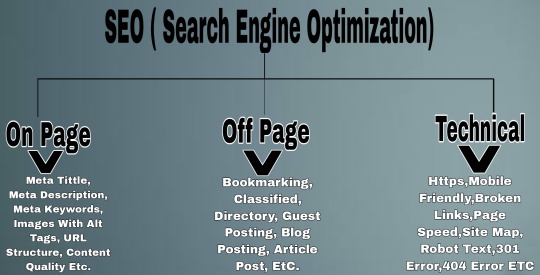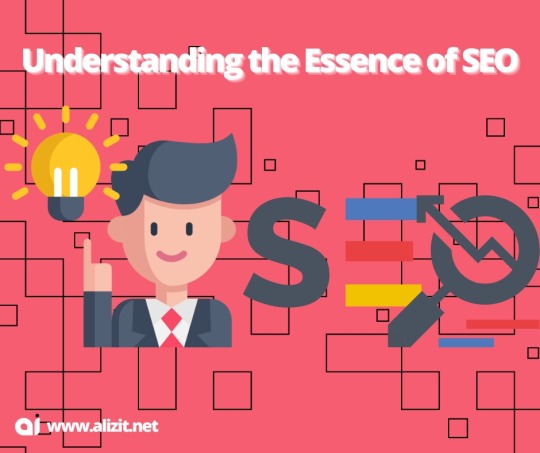#What is SEO
Explore tagged Tumblr posts
Text
SEO Hindi Me Kya Hai? Know Complete Information In Just 2 Minutes

Curious about SEO Kya Hai? Search Engine Optimization (SEO) is the process of improving website visibility on search engines like Google.
By optimizing content and following best practices, you can increase organic traffic to your site. It involves keyword research, meta tags optimization, link building, and more.
Understanding SEO is crucial for boosting online presence and reaching a wider audience. Stay tuned for more insights on how to enhance your digital marketing strategy with effective SEO techniques!
. 🌐 Click the link above to read more! . Contact us here:-👇 . 📧 Official Gmail ID: [email protected] . 👉 Follow us to get more informative posts: @akgtechinfo
#what is seo#seo tips#digital marketing#search engine optimization#seo basics#seo for beginners#online marketing#seo training#grow your business#digital strategy#inbound marketing#seo
4 notes
·
View notes
Text
What is SEO and how does it work?
SEO stands for Search Engine Optimization. It's a set of practices aimed at improving a website's visibility in search engine results pages (SERPs). The goal is to increase the quantity and quality of organic (non-paid) traffic to a website. Here’s a breakdown of how it works:
Keyword Research: This involves identifying the words and phrases that people are using to search for information related to your site. Tools like Google Keyword Planner or Ahrefs can help you find relevant keywords with good search volume and low competition.
On-Page SEO: This focuses on optimizing individual pages on your site to rank higher. Key elements include:
Title Tags: Descriptive and keyword-rich titles for each page.
Meta Descriptions: Short summaries of page content that appear in search results.
Headings: Using proper heading tags (H1, H2, etc.) to organize content.
Content Quality: Creating high-quality, relevant content that answers users’ queries.
Internal Linking: Linking to other pages within your site to improve navigation and spread link equity.
Technical SEO: This ensures that search engines can crawl and index your site efficiently. It includes:
Site Speed: Ensuring your site loads quickly.
Mobile-Friendliness: Making sure your site is responsive and works well on mobile devices.
Sitemap: Creating and submitting a sitemap to help search engines understand the structure of your site.
Robots.txt: Directing search engines on which pages to crawl and which to ignore.
Off-Page SEO: This involves activities outside your site that impact its authority and rankings. Key elements include:
Backlinks: Getting other reputable sites to link to your content. Quality backlinks act as endorsements of your site’s credibility.
Social Signals: Engagement on social media platforms can indirectly influence rankings.
User Experience (UX): Improving the overall experience on your site, such as easy navigation, engaging content, and a clean design, helps retain visitors and reduce bounce rates.
Analytics and Monitoring: Using tools like Google Analytics and Google Search Console to track your site’s performance, monitor traffic sources, and adjust strategies based on data.
SEO is an ongoing process since search engines frequently update their algorithms. Staying current with SEO best practices and adapting to changes is crucial for maintaining and improving your site's rankings.

4 notes
·
View notes
Text
What is SEO/Search Engine Optimization and How does it Work?
SEO stands for "search engine optimization". In simple, it is a process of improving your webpage to increase its visibility in search engines like Google, Bing, etc. You would get more chances to gain attention when your webpage is more visible in search engine results pages (SERPs).

#search engine optimization#seo#what is seo#seo tips#seo tools#seo techniques#seo tags:#seo training#social media marketing#digital marketing#marketing
5 notes
·
View notes
Text
● What is seo ? & seo Techniques.
SEO stands for "search engine optimization". In simple, it is a process of improving your webpage to increase its visibility in search engines like Google, Bing, etc. You would get more chances to gain attention when your webpage is more visible in search engine results pages (SERPs).
How does SEO work?
Search engines such as Google and Bing use their crawling bots to crawl webpages on the web, they crawl sites to sites, collect information and put them in an index. Index is like a library of webpages where search engines help you to find most suitable results for your query.
After indexing, algorithms rank webpages according to the search engine's ranking factors, to make sure what would be the order of webpages in SERPs for a given query.
Most important ranking factor is "user experience". Bots try to deliver the best webpage for what a user is searching for.
SEO is a organic way to increase the visibility and you don't pay anything to search engines to get higher ranking but you should have a SEO experts for this.
FOR MORE INFORMATION
https://www.salmantravoblog.xyz/2022/01/best-seo-techniques-of-2022.html?m=1

2 notes
·
View notes
Text
The Ultimate SEO Checklist for Online Coaches in 2024
As an online coach in 2024, leveraging SEO is paramount to attracting more clients and establishing your authority in a competitive digital landscape. SEO, or Search Engine Optimization, is a crucial tool for improving your online visibility and driving organic traffic to your coaching website. Below is the ultimate SEO checklist tailored for online coaches looking to optimize their digital presence effectively.

1. Comprehensive Keyword Research
Begin with thorough keyword research to identify terms your potential clients are searching for. Focus on long-tail keywords related to your coaching niche, services, and common questions your audience might have. Tools like Google Keyword Planner, Ahrefs, or SEMrush can provide valuable insights into search volume and competition levels.
2. Optimized Website Structure
Ensure your website has a clear, logical structure that’s easy for both users and search engines to navigate. Use a straightforward menu with clearly labeled sections and a sitemap to help search engines crawl your site more effectively.
3. High-Quality, Relevant Content
Content is king in the world of SEO. Produce high-quality, informative blog posts, articles, and resources that address the needs and questions of your target audience. Regularly updating your site with fresh content can improve your search engine rankings and keep visitors coming back.
4. On-Page SEO Optimization
For every piece of content you create, ensure you're implementing on-page SEO best practices. This includes using your chosen keywords in titles, headers, meta descriptions, and throughout the content in a natural, reader-friendly way. Also, optimize images by compressing them for faster loading times and using descriptive file names and alt text.
5. Mobile Responsiveness
With the majority of internet browsing now done on mobile devices, your website must be mobile-friendly. Google uses mobile-first indexing, so a responsive design that adjusts to various screen sizes is essential for SEO.
6. Page Load Speed
A slow website can significantly increase your bounce rate and negatively impact your SEO. Use tools like Google PageSpeed Insights to check your site’s speed and follow the recommendations to improve load times, such as compressing images and minimizing the use of large files.
7. Secure Website with HTTPS
Security is a top priority for Google and your potential clients. Ensure your website uses HTTPS encryption to protect user data and improve your site’s trustworthiness and search ranking.
8. Backlink Strategy
High-quality backlinks from reputable websites in your niche can greatly enhance your SEO. Focus on building relationships with other coaches, industry websites, and influencers to earn links that boost your site’s authority.
9. Local SEO for Local Coaches
If you offer coaching services in a specific area, local SEO can be incredibly beneficial. Claim your Google My Business listing, include local keywords in your content, and ensure your business is listed accurately on local directories.
10. Analyzing and Refining Your SEO Strategy
SEO is not a set-it-and-forget-it task. Use tools like Google Analytics and Google Search Console to track your website's performance, understand how visitors are finding you, and identify areas for improvement. Regularly reviewing and updating your SEO strategy based on performance data is key to staying ahead in search rankings.
11. Engaging Social Media Presence
While social media doesn’t directly influence SEO rankings, it can drive traffic to your website and increase your online visibility. Share your content on social media platforms where your potential clients are active, and engage with your audience to build your brand.
12. User Experience (UX)
Google values websites that provide a good user experience. This includes easy navigation, fast load times, and engaging, valuable content. Ensure your website is designed with the user in mind to not only satisfy search engines but convert visitors into clients.
This SEO checklist for online coaches in 2024 highlights the importance of a comprehensive, multi-faceted approach to optimizing your online presence. By following these steps, you can improve your visibility in search engine results, attract more potential clients, and establish yourself as a leading authority in your coaching niche.
4 notes
·
View notes
Text
What is SEO, and How Does It Work?
In the vast landscape of the internet, where countless websites vie for attention, Search Engine Optimization (SEO) stands as the beacon that guides users to discover valuable content. Understanding the intricacies of SEO is paramount for anyone looking to establish a digital presence, whether for personal blogs, e-commerce sites, or corporate entities. In this comprehensive guide, we’ll delve into the depths of SEO, exploring its definition, importance, and the fundamental principles that govern its workings.

I. What is SEO?
Search Engine Optimization, commonly known as SEO, is the practice of optimizing a website or online content to enhance its visibility and ranking on search engine results pages (SERPs). The main objective of SEO is to enhance the flow of natural (unpaid) traffic to a website, ultimately leading to an influx of pertinent visitors and potential customers.
A. The Evolution of SEO:
SEO has evolved significantly over the years, adapting to the ever-changing algorithms and ranking criteria of search engines. Initially, SEO focused on keyword optimization and link-building strategies, but contemporary SEO involves a holistic approach that considers various factors, including user experience, content quality, and technical aspects.
II. How Does SEO Work?
Understanding the mechanics of SEO requires delving into its core components. SEO operates based on the algorithms of search engines, with Google being the predominant player in the search engine landscape. The process involves a combination of on-page and off-page optimization techniques, aiming to align a website with the criteria that search engines consider when ranking results.
A. On-Page Optimization:
Keyword Research and Usage:
Identifying relevant keywords that align with the content and target audience.
Strategically placing keywords in titles, headers, meta descriptions, and throughout the content.
Content Quality and Relevance:
Producing content that is both high-quality and pertinent, effectively catering to the target audience’s requirements, while also ensuring engagement.
Regularly updating content to stay current and informative.
User Experience:
Ensuring a user-friendly website design with easy navigation and fast loading times.
Optimizing for mobile devices to accommodate the increasing number of mobile users.
B. Off-Page Optimization:
Link Building:
Acquiring high-quality backlinks from reputable websites to establish credibility.
Building a diverse and natural link profile to enhance authority.
Social Signals:
Leveraging social media platforms to promote content and engage with the audience.
Encouraging social sharing to increase visibility and reach.
III. The Importance of SEO:
A. Increased Visibility and Traffic:
SEO enhances a website’s visibility on SERPs, making it more likely for users to discover the content.
Higher rankings result in increased organic traffic, reducing the reliance on paid advertising.
B. Credibility and Trust:
Websites that rank higher are often perceived as more credible and trustworthy by users.
Establishing authority through SEO contributes to a positive brand image.
C. Cost-Effectiveness:
Compared to paid advertising, organic traffic generated through SEO is a cost-effective long-term strategy.
Continuous optimization leads to sustained visibility without ongoing advertising expenses.
IV. Common SEO Challenges and Solutions:
A. Algorithm Updates:
The impact of frequent algorithm updates and how to adapt strategies accordingly.
The importance of staying informed about industry trends and best practices.
B. Competitive Landscape:
Analyzing competitors’ strategies and finding unique ways to stand out.
Implementing continuous improvement to maintain and advance rankings.
C. Technical Issues:
Identifying and addressing technical issues that may affect SEO, such as website speed, broken links, and mobile responsiveness.
The role of technical SEO audits in maintaining a healthy website.
V. The Future of SEO:
A. Voice Search and AI:
The rise of voice search and the need to optimize for natural language queries.
The integration of artificial intelligence (AI) in search algorithms and its implications for SEO.
B. User Experience and Core Web Vitals:
Google’s emphasis on user experience metrics, including Core Web Vitals, in ranking algorithms.
Strategies to enhance user experience and meet evolving search engine criteria.
VI. Conclusion:
In the dynamic realm of the internet, where the landscape is ever-shifting, mastering the art of SEO is essential for anyone seeking online success. From the basics of keyword optimization to the intricacies of technical SEO, this comprehensive guide has provided a roadmap for understanding and implementing effective SEO strategies. As the digital ecosystem continues to evolve, staying abreast of SEO trends and best practices will empower individuals and businesses to navigate the competitive online terrain and secure their place at the top of search engine results.
Source- https://adilraseed.com/what-is-seo/
4 notes
·
View notes
Text
Mastering SEO in 7 days. Build a strong online presence
Hi there dear people! This article is about how to grow your startup using SEO (Search Engine Optimization). I am sure it will help you! Wish you best of all!
“The beauty of SEO is that, instead of pushing a marketing message onto folks who don’t want to hear what you have to say, you can reverse-engineer the process to discover exactly what people are looking for and create content that they will naturally find.” – David Amerland Table of contents What SEO is?Mastering SEO in 7 Days. Build a strong online presenceWhy SEO is essentialSEO Tips What…

View On WordPress
2 notes
·
View notes
Text

Search engine optimization (SEO) is the process of optimizing a website to enhance its visibility and organic rankings on search engine result pages (SERPs). It involves various strategies and techniques aimed at improving the website's relevance, authority, and user experience. SEO plays a pivotal role in driving organic traffic, increasing brand visibility, and attracting valuable leads in the fiercely competitive digital marketing arena.
About us.
3 notes
·
View notes
Text
youtube
#internal link building#internal linking#internal links#internal link#seo#what is seo#seo tutorial#Youtube
2 notes
·
View notes
Text
Hello everyone!
I'm here to share my SEO knowledge. As I am starting my journey into SEO I would like to share my knowledge, my learning experience and what I understand about SEO with you.
I am very excited to start my career in this field. I welcome your thoughts and opinions. Every single piece of information matters a lot to me.
If you want to add or change something in my post, please let me know, it will help me to learn more about SEO.
Let's learn SEO together.
#digitalmarketing#seo#learnseo#what is seo#seo tools#seomeaning#searchengine#optimization#googlesearch#seotechniques#searchengineoptimization
3 notes
·
View notes
Text
Why Should You Learn Digital Marketing & SEO in 2025? (The Raw Truth!)
Listen up! Everyone’s screaming "Learn Digital Marketing!"—but why? Let’s cut the fluff.
Money Talks (Earn More, Work Smarter) Freelancing: SEO experts charge 50 − 50−200/hour on Upwork!
Boost Your Business: Get free traffic to your Shopify/eCom store.
Job Market: In Bangladesh, digital marketers earn 25k-80k+ BDT/month.
Real Example: Rafiq bhai makes 3 lakh BDT/month from Fiverr after learning SEO!
Future-Proof Your Career Google/Facebook update algorithms, but core SEO skills never die.
AI won’t replace human creativity in marketing!
Fun Fact: 87% of Bangladeshi businesses now need social media marketers!
Be Your Own Boss (Freedom > 9-to-5) Work from home (no office politics!)
10+ income streams (affiliate, ads, client projects)
Halal earnings (sell skills, not time)
Truth Bomb: A laptop + internet = Your global marketplace!
Low-Cost, High-Reward Learning Free on YouTube (Ahrefs, HubSpot Academy)
Master it in 6 months (with practice)
Course cost = Just 1-2 project earnings!
My Story: I started with a 1,000 BDT Udemy course—now earning 5 lakh+ BDT/month!

Still Doubting? Meet Khalid (a Dhaka guy):
Learned SEO for 3 months
Now gets 10+ clients/month (1.5 lakh BDT income)
His secret? Consistency + Right Learning!
Start TODAY:
Google "SEO basics"
Watch 1 free YouTube course
Grab your first project on Fiverr/Upwork
Remember: "Those who learn WILL succeed—it’s just a matter of time!"
Got questions? Drop a comment! (I walked this path—DM me for real-talk advice!)
#what is seo#what is digital marketing#seo services#digital marketing#learndigitalmarketing#learnseo
1 note
·
View note
Text
What Are the Benefits of SEO? | AEOLUS Digital Podcast
In this episode of the AEOLUS Digital Podcast, we explore the powerful and long-lasting benefits of SEO — Search Engine Optimization. Whether you're a business owner, marketer, or just curious about digital strategies, you'll learn how SEO can drive organic traffic, reduce marketing costs, build trust, improve user experience, and give your brand a competitive edge. We break it all down in a clear, practical way so you can start making smarter decisions about your online presence. Tune in and discover why SEO isn’t just important — it’s essential for sustainable growth in today’s digital world. Visit: https://aeolusdigital.com/
0 notes
Text
What is SEO? Increase Your Website Traffic & Visibility
Learn what is SEO can boost your website's visibility in search engine results pages (SERPs) and drive organic traffic. Discover the key strategies to improve your search rankings and reach a wider audience.
Read the full information - https://digitalexpertsindia.com
0 notes
Text
How to Implement White Hat SEO for the Most Amazing Results!

White hat SEO stands as the foundation of ethical and highly effective search engine optimization.
It prioritizes user experience, transparency, and adherence to search engine guidelines, fostering long-term success and sustainable growth.
To implement white hat techniques effectively, a strategic approach focusing on quality content, technical optimization, and user-first practices is essential.
GetFound will reveal a step-by-step guide on how to effectively leverage white hat SEO for your website. Read carefully!
1. Create High-Quality, User-Centric Content
Content is the backbone of white hat, and its quality directly impacts rankings, engagement, and trustworthiness. To implement white hat SEO effectively, focus on creating valuable content that prioritizes user experience.
Here's how to implement this:
Understand Your Audience
Conduct keyword research and audience analysis to identify what users are searching for and their pain points. Tools like Google Keyword Planner or SEMrush can help pinpoint relevant topics.
Write for Humans, Not Just Algorithms
Produce content that is informative, engaging, and easy to read. Avoid keyword stuffing; instead, integrate keywords naturally into your content.
Focus on Originality and Value
Offer unique insights, solutions, or perspectives that differentiate your content from competitors. Plagiarism or duplicate content can harm rankings and credibility.
Utilize Multimedia Elements
Use videos, infographics, and images to make your content more engaging and visually appealing, which can increase dwell time and user interaction.
High-quality content not only attracts users but also encourages backlinks, a critical factor in SEO success.
2. Optimize Website Structure and Navigation
Websites that are well-organized ensures a positive user experience and helps search engines crawl and index your pages more effectively.
Key steps include:
Use a Logical Site Architecture
Structure your site with clear categories and subcategories.
Improve Internal Linking
Link related pages to help users navigate your site and distribute link equity across your content.
Implement a Clear URL Structure
Use descriptive, short URLs that include target keywords.
Create a Sitemap
Submit an XML sitemap to search engines to help them understand and index your site structure efficiently.
A seamless navigation experience not only reduces bounce rates but also improves the likelihood of conversion.
3. Ensure Mobile-Friendliness and Responsive Design
With the majority of internet traffic coming from mobile devices, optimizing your site for mobile users is a critical white hat SEO practice.
To implement white hat effectively, prioritize mobile optimization to enhance user experience across all devices.
Use a Responsive Design
Ensure your site adapts to various screen sizes and devices seamlessly.
Improve Mobile Page Speed
Use tools like Google’s PageSpeed Insights to identify and fix issues that slow down mobile page loading times.
Optimize for Touch Navigation
Design buttons, menus, and interactive elements to be easily usable on mobile screens.
Search engines reward mobile-friendly sites with better rankings, making this a vital aspect of white hat SEO.
4. Implement Ethical Link-Building Strategies
Backlinks remain one of the most influential ranking factors in SEO. However, white hat SEO emphasizes earning links naturally and ethically.
Create Link-Worthy Content
High-quality, shareable content such as blog posts, case studies, or research reports attracts organic backlinks.
Engage in Guest Blogging
Write for reputable websites in your niche to gain exposure and earn links. Ensure the content adds value and is not overly promotional.
Reach Out for Collaboration
Build relationships with industry influencers, bloggers, and websites to secure legitimate backlinks.
Avoid Link Schemes
Stay away from buying links, link farms, or excessive reciprocal linking, as these practices violate search engine guidelines.
Ethical link-building fosters authority and trust while protecting your site from penalties.
5. Optimize On-Page SEO Elements
On-page SEO ensures that individual pages are optimized for both search engines and users.
When you implement white hat SEO, focus on the following elements to improve both usability and rankings:
Meta Tags
Write compelling title tags and meta descriptions that include target keywords and encourage clicks.
Header Tags
Use H1, H2, and H3 tags to structure your content and make it easier to read.
Alt Text for Images
Add descriptive alt text to images to improve accessibility and image search rankings.
Keyword Optimization
Use keywords strategically in the content, headers, and meta tags without overloading.
A well-optimized page enhances visibility and user engagement.
Also Read: How Significant is the Impact of Pogo Sticking in SEO?
6. Improve Site Performance and Technical SEO
Technical SEO is an integral part of white hat practices, ensuring that your site is fast, secure, and accessible.
Increase Page Speed
Compress images, enable browser caching, and use a content delivery network (CDN) to improve loading times.
Use HTTPS
Secure your site with an SSL certificate to protect user data and improve trustworthiness.
Fix Crawl Errors
Use tools like Google Search Console to identify and resolve issues such as broken links or server errors.
Implement Schema Markup
Add structured data to your pages to enhance search result features like rich snippets.
Technical optimizations not only enhance user experience but also signal quality to search engines.
7. Monitor and Analyze SEO Performance
White Hat SEO is an ongoing process that requires regular monitoring and adjustments.
To effectively implement white hat SEO, follow these steps:
Use Analytics Tools
Platforms like Google Analytics and Search Console help track performance metrics, such as organic traffic, bounce rates, and click-through rates (CTR).
Conduct Regular Audits
Review your site’s technical health, content quality, and backlink profile periodically.
A/B Testing
Experiment with different strategies, such as call-to-action placements or headline variations, to determine what resonates best with your audience.
Stay Updated
Keep abreast of the latest algorithm updates and SEO trends to adapt your strategies accordingly.
Monitoring ensures that your efforts yield the desired results while identifying areas for improvement.
Follow GetFound’s Guide Closely to Succeed in Your SEO Plan!
Implementing white hat SEO is a commitment to ethical, user-focused, and sustainable practices that align with search engine guidelines.
By focusing on quality content, technical optimization, and user experience, you can build a strong online presence and achieve lasting success in search engine rankings.
When you implement white hat techniques, you not only ensure compliance but also foster trust and authority, making it an indispensable strategy for businesses seeking long-term growth and a positive reputation in the digital landscape.
1 note
·
View note
Text
Search engine optimization (SEO) is the practice of getting targeted traffic to a website from a search engine’s organic (unpaid) rankings. The goal of SEO is to rank
0 notes